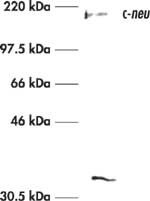OP15L Sigma-AldrichAnti-c-ErbB2/c-Neu (Ab-3) Mouse mAb (3B5)
Anti-c-ErbB2/c-Neu (Ab-3), mouse monoclonal, clone 3B5, recognizes the ~185 kDa c-ErbB2/c-Neu protein in HEK293 cells. It is validated for WB, IF, IP, and IHC on frozen and paraffin sections.
More>> Anti-c-ErbB2/c-Neu (Ab-3), mouse monoclonal, clone 3B5, recognizes the ~185 kDa c-ErbB2/c-Neu protein in HEK293 cells. It is validated for WB, IF, IP, and IHC on frozen and paraffin sections. Less<<Synonyms: Anti-ErbB2, Anti-Erythroblastosis Virus, Anti-Human Epidermal Growth Factor, Anti-HER2, Anti-Neu
Recommended Products
Overview
| Replacement Information |
|---|
Key Specifications Table
| Species Reactivity | Host | Antibody Type |
|---|---|---|
| H, M | M | Monoclonal Antibody |
Pricing & Availability
| Catalog Number | Availability | Packaging | Qty/Pack | Price | Quantity | |
|---|---|---|---|---|---|---|
| OP15L-100UG |
|
Glass bottle | 100 μg |
|
— |
| Product Information | |
|---|---|
| Form | Lyophilized |
| Formulation | Lyophilized from 20 mM ammonium bicarbonate Buffer, 100 µg FAF-BSA. |
| Negative control | HepG2 cells or normal skin |
| Positive control | SK-BR-3 cells or breast carcinoma tissue |
| Preservative | None |
| Quality Level | MQ100 |
| Physicochemical Information |
|---|
| Dimensions |
|---|
| Materials Information |
|---|
| Toxicological Information |
|---|
| Safety Information according to GHS |
|---|
| Safety Information |
|---|
| Product Usage Statements |
|---|
| Packaging Information |
|---|
| Transport Information |
|---|
| Supplemental Information |
|---|
| Specifications |
|---|
| Global Trade Item Number | |
|---|---|
| Catalog Number | GTIN |
| OP15L-100UG | 04055977224641 |
Documentation
Anti-c-ErbB2/c-Neu (Ab-3) Mouse mAb (3B5) SDS
| Title |
|---|
Anti-c-ErbB2/c-Neu (Ab-3) Mouse mAb (3B5) Certificates of Analysis
| Title | Lot Number |
|---|---|
| OP15L |
References
| Reference overview |
|---|
| Mamcs, J.R., et al. 1994. Ann. Surg. 219, 332. Tetu, B., et al. 1994. Cancer 73, 2359. DiFiore, P.P., et al. 1987. Science 237, 178. Slamon, D.J., et al. 1987. Science 235, 177. Varley, J.M., et al. 1987. Oncogene 1, 423. Bargmann, C.I., et al. 1986. Nature 319, 226. Yamamoto, T., et al. 1986. Nature 319, 230. Blick, M., et al. 1984. Blood 64, 1234. Schwab, M., et al. 1984. Cold Spring Harbor Laboratory 2, 215. |
Citations
| Title | |
|---|---|
|
|








